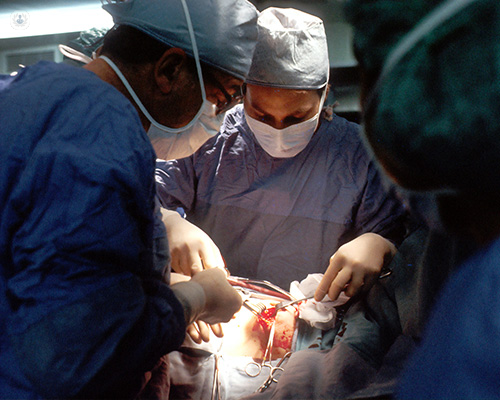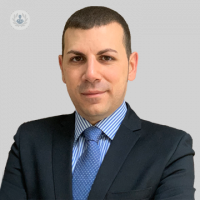What is aortic root surgery?
Aortic root surgery is a surgical procedure for an enlarged aorta, often known as an aortic aneurysm. The aorta is a large blood vessel that transports blood from your heart to your body. The aortic root is the first segment of the aorta as it emerges from the heart. It holds the aortic valve and the coronary arteries.
Why is aortic root surgery done?
This surgery is carried out to prevent a rupture of an aneurysm or a tear in the internal layer of the aortic wall (aortic dissection). Aortic aneurysms near the aortic root are sometimes related to a bicuspid aortic valve, Marfan syndrome, and other genetic diseases.

What happens during the surgery?
The surgery can be performed in different ways depending on what the problem is. Some types of surgery are as follows:
- Aortic valve and root replacement: in this type of root surgery, the aortic root and the aortic valve are cut out and replaced with a synthetic tube for the aorta and an artificial valve (mechanical or bioprosthetic).
- Valve sparing aortic root replacement: this type of procedure is technically more demanding. The aortic root is replaced, while the patient's healthy aortic valve is preserved.
Surgery is recommended based on the size of the aortic aneurysm, which varies depending on whether there is a genetic cause or not.
Preparation for aortic root surgery
Before undergoing aortic root surgery, an aortic sub-specialist will explain to you what the procedure is, why it is done, as well as the risks involved and the benefits this surgery will bring to you.
After-care
The procedure takes around four to five hours. The hospital stay is approximately one week.
Full recovery and return to normal activity usually takes 8 to 12 weeks, to allow for the breast bone to heal completely.
What type of surgeon performs aortic root surgery?
Aortic surgery is usually performed by a cardiac surgeon who specialises in aortic surgery.
11-13-2012 05-20-2015Aortic root surgery
Mr Ahmed Othman - Cardiothoracic surgery
Created on: 11-13-2012
Updated on: 05-20-2015
Edited by: Jay Staniland
What is aortic root surgery?
Aortic root surgery is a surgical procedure for an enlarged aorta, often known as an aortic aneurysm. The aorta is a large blood vessel that transports blood from your heart to your body. The aortic root is the first segment of the aorta as it emerges from the heart. It holds the aortic valve and the coronary arteries.
Why is aortic root surgery done?
This surgery is carried out to prevent a rupture of an aneurysm or a tear in the internal layer of the aortic wall (aortic dissection). Aortic aneurysms near the aortic root are sometimes related to a bicuspid aortic valve, Marfan syndrome, and other genetic diseases.

What happens during the surgery?
The surgery can be performed in different ways depending on what the problem is. Some types of surgery are as follows:
- Aortic valve and root replacement: in this type of root surgery, the aortic root and the aortic valve are cut out and replaced with a synthetic tube for the aorta and an artificial valve (mechanical or bioprosthetic).
- Valve sparing aortic root replacement: this type of procedure is technically more demanding. The aortic root is replaced, while the patient's healthy aortic valve is preserved.
Surgery is recommended based on the size of the aortic aneurysm, which varies depending on whether there is a genetic cause or not.
Preparation for aortic root surgery
Before undergoing aortic root surgery, an aortic sub-specialist will explain to you what the procedure is, why it is done, as well as the risks involved and the benefits this surgery will bring to you.
After-care
The procedure takes around four to five hours. The hospital stay is approximately one week.
Full recovery and return to normal activity usually takes 8 to 12 weeks, to allow for the breast bone to heal completely.
What type of surgeon performs aortic root surgery?
Aortic surgery is usually performed by a cardiac surgeon who specialises in aortic surgery.


Minimal access (keyhole) aortic root surgery: advantages, preparation and recovery
By Professor Aung Ye Oo
2024-11-18
Minimal aortic surgery involves making small incisions in the skin of the sternum to reach the aortic root, which is the section of the aorta that is attached to the heart. The aorta is a large blood vessel that transports blood from your heart to your body. Professor Aung Ye Oo is here to tell us more about this procedure. See more
Experts in Aortic root surgery
-
Mr Shahzad Raja
Cardiothoracic surgeryExpert in:
- Aortic root surgery
- TAVI (transcatheter aortic valve implantation)
- Aortic valve replacement
- Coronary surgery
- Heart valve surgery
- Minimally invasive cardiac surgery
-
Professor Aung Ye Oo
Cardiothoracic surgeryExpert in:
- Aortic root surgery
- Heart valve surgery
- Coronary bypass surgery
- Aortic valve replacement (minimally invasive)
- Marfan syndrome
- Aortic valve replacement
-
Mr Alberto Albanese
Cardiothoracic surgeryExpert in:
- Coronary bypass surgery
- Beating heart coronary heart bypass surgery (minimally invasive)
- Aortic valve replacement (minimally invasive)
- Mitral valve repair (minimally invasive)
- Aortic root surgery
- Minimally invasive cardiac surgery
-
Mr Ahmed Othman
Cardiothoracic surgeryExpert in:
- Aortic root surgery
- Aortic valve replacement
- Heart bypass
- Heart valve surgery
- Transcatheter aortic valve implantation (TAVR)
- Valvular repair surgery
-
Miss Indu Deglurkar
Cardiothoracic surgeryExpert in:
- Aortic root surgery
- Mitral valve repair (minimally invasive)
- Aortic valve replacement
- Endoscopic coronary artery bypass surgery
- Heart valve surgery
- See all

The Harley Street Clinic - part of HCA Healthcare
The Harley Street Clinic - part of HCA Healthcare
35 Weymouth Street, London. W1G 8BJ
No existe teléfono en el centro.
By using the telephone number provided by TOP DOCTORS, you automatically agree to let us use your phone number for statistical and commercial purposes. For further information, read our Privacy Policy
Top Doctors

The Wellington Hospital - part of HCA Healthcare
The Wellington Hospital - part of HCA Healthcare
Wellington Hospital South Bldg, 8A Wellington Pl, NW8 9LE
No existe teléfono en el centro.
By using the telephone number provided by TOP DOCTORS, you automatically agree to let us use your phone number for statistical and commercial purposes. For further information, read our Privacy Policy
Top Doctors
-
The Harley Street Clinic - part of HCA Healthcare
35 Weymouth Street, London. W1G 8BJ, Central LondonExpert in:
- Cancer
- Head and neck cancer
- Cardiology
- Intensive care
- Diagnostic Imaging
- Women’s health
-
The Wellington Hospital - part of HCA Healthcare
Wellington Hospital South Bldg, 8A Wellington Pl, NW8 9LE, Central LondonExpert in:
- Digestive
- Cardiology
- Orthopaedic surgery
- Orthopaedic spinal surgery
- Intensive care
- Spine
- See all
- Most viewed diseases, medical tests, and treatments
- Minimal access surgery (keyhole surgery)
- Aortic aneurysms
- Medicolegal
- Robotic surgery
- MRI
- Interventional cardiology
- Lung cancer
- Coronary surgery
- Atrial fibrillation ablation
- Coronary bypass surgery






